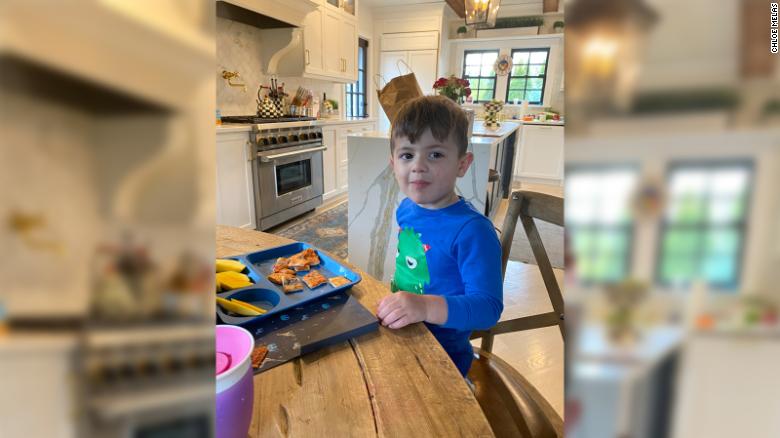How to encourage a healthy relationship with food in children?
3:39
(CNN) --
"Who wants pasta?"
I tell my kids as I peek into the pantry.
"Me!" my two sons, ages 2 and 4, yell in unison.
I put the water to boil and add the pasta, but without any sauce because my children prefer it with butter.
I ask the children what color they want the plates.
Without fail, my 4-year-old yells, "I want green!" while my 2-year-old throws his hands at each other excitedly, "Blue, blue, Mommy!"
I put plates in front of them garnished with sliced strawberries and some diluted apple juice in their glasses, and pour myself a glass of wine.
I feel fulfilled, but 15 minutes later that feeling dissipates.
My kids haven't touched anything on their plates except a few strawberries.
"I don't like it!" my youngest son says with a grimace.
Without looking up, the 4-year-old says, "I want a popsicle."
advertising
Here we go again, I think.
The next 30 minutes consist of bribing them to eat a few more bites in exchange for something sweet.
I find myself feeding my home cooked food to our dog, Franky.
He is the best fed member of our house.
Turns out I'm not the only one struggling with dinnertime drama.
Being a picky eater is common among young children.
According to the National Center for Biotechnology Information, up to 50% do not want to eat vegetables or try new foods.
Children's dishes should be colorful and parents should make mealtimes fun, experts say.
Preparing a meal for my kids is half the battle, whether they eat it or not, psychologist Alli Delozier told me in a recent interview.
"Take the pressure off them to eat at the table," Delozier said.
"Just by putting food on their plates or on the table, you're doing a great job as a parent because you keep exposing them to that food. They see it, they smell it, they touch it and they taste it. And every time they have that exposure, they're one step ahead. closer to learning to like that food.
Several parents in my circle of friends told me to check out an Instagram account called "Kids Eat in Color."
Jennifer Anderson, a registered dietitian, created the page, amassing more than 1 million followers seeking what she says is "evidence-based information and strategies for infant feeding and nutrition."
“This is the age where (your children's) greatest power is to say no and have opinions,” Anderson said. “And so this is totally to be expected.
They're not doing anything wrong."
And what happens to my anxiety when my children do not eat the food?
Anderson said that's normal, too.
"What happens is when kids say no, as parents we tend to get really worried, like, 'Oh my God, they're not going to eat. They're not going to grow. They're going to get sick.' ... And because of that fear, we do a lot of stuff," Anderson told me.
"We put a screen in front of them so they can eat better. We prepare what they want. We tell them: 'OK, you can eat all day. I'll follow you with this spoon,'" he added.
"We've all done it, like chasing after the kid saying, 'Have a bite.' We started saying things like, 'Have a bite or I'll take your iPad. things to a little kid whose greatest power is to say, 'Are you telling me to do that? No way.' And so we fall into these habits that really hurt us in the long run."
How to encourage a healthy relationship with food in children?
3:39
My kids want breaded chicken strips every night.
It's okay?
According to both experts, yes: give your children what they want to eat.
"We always want to serve a meal that the child is comfortable with," Anderson said.
"If you know that they generally like macaroni and cheese, or that they generally like peanut butter and jelly, or that they generally like apples and strawberries, we always want to have something on the table that they generally like, but we also have to respect their kind of bodily autonomy".
"You don't have to eat it...if you don't want to eat it, and we respect that. We're actually laying the groundwork early on for them to decide that they can choose what happens to their body, and that has far-reaching effects for many people." stuff".
Introduce new foods to your child by putting other options on the table.
And make it look fun!
Your child's plate should be colorful.
"Each different color is due to chemicals in the food that are doing specific things in our bodies," Anderson said.
"When we think, 'Hey, I'm giving my kid a wide range of colors,' I know they're getting nutrients without obsessing over specific things like are they getting enough vitamin C? Calcium? Are they getting enough magnesium? So if they eat a range of colors as children, or at least if they're exposed to it, they're more likely to eat a more varied diet later on."
Vegetarian and meat-eating children have similar growth and nutrition, but not the same weight: study
And the introduction of new foods?
Yes, it's a good idea, experts say.
But you have to expose children to new foods by putting some other options on the table.
"Do you have to put everything on the plate? No," Anderson said.
"If you have a kid who says, 'I don't like peas. I like to put what I call a micro-portion on their plate. That is, I would put just one pea. It's not scary, but they still have that exposure."
"And say something like, 'This is what's available for lunch. You can choose what to eat from what's here.'"
And the sweets?
Delozier says that candy is fine, but don't use it as a reward.
"It's very easy to say, 'Well, if you're done with the green beans, you can have a popsicle.' We've all fallen into that trap, but letting them just have the thing and not putting it on a pedestal and not making it a food reward can be helpful. And then you decide how often your family is okay with it, whether it's having dessert every night or having ice cream after school or once a week. That's up to you."
Some tips from 'Kids Eat in Color'
Do not prepare anything else.
Do not take it personally.
Let them fill up with other parts of the food.
Don't celebrate when they run out of food.
Serve food formally and consistently.
Sit down at mealtime and snack time.
Do not force or bribe your children to eat any food.
I usually let my kids play games or look at their iPads during lunch, but both experts told me I should stop.
"We really try to make it a calm environment to eat, where they can focus on food and connecting with family members," Delozier said.
"We don't want to have screens on the table. We don't want there to be toys and things like that. And that's something that may take some time to figure out."
When should you worry?
But there are situations where it's about more than selective eating.
When should you go to a professional?
"When you have a child who isn't on their growth chart, whose pediatrician is concerned that they're not gaining weight, especially if they're losing weight, those are all definite reasons to be concerned," Delozier said.
In the last week, I put bribes behind me and tried microportions.
I have noticed a gradual increase in the amount of food my children eat.
Ultimately, what I learned is that there is no linear path to mealtime.
"As a psychologist and a parent, I can say that much of our beliefs about what children should eat and how we should feed our children are informed by our own beliefs about food and how we feed ourselves," Delozier said.
"You have to take food off a pedestal (and) make it more neutral. (Then your kids will be) more likely to be able to tune in to their hunger cues and eat based on hunger and make decisions that are in accordance with their hunger cues." family values".
FoodWell-being children








